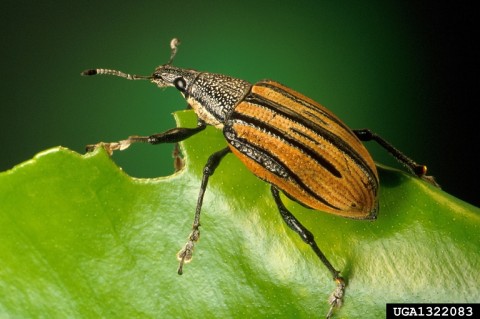
Root weevils create unsightly notches in the leaves of some evergreen shrubs. Photo: Keith Weller, USDA Agricultural Research Service, Bugwood.org
It seems like the root weevil notching appears out of nowhere. Because the adult root weevils feed at night, we see the damage but no insects. Notched leaves, especially along the edges, are a sign that root weevils are at work.
These insects primarily chew on broadleaf evergreen shrubs. In particular, they seem to love rhododendrons, azaleas, pieris, viburnums and laurels. Because these plants take a while to lose their leaves, the notching will stay visible for many years.
Mild to severe notching of new leaves is mainly an aesthetic nuisance and will usually not damage the plant’s overall health. But it can be a sign that the plants are under stress.
How to limit root weevil activity and damage
Use appropriate water and organic mulch, such as compost or arborist chips, to keep your shrubs healthy.
Prune up branches that touch the ground to reduce access. Root weevils need to travel along branches to get to the leaves.
Apply sticky or slippery barriers around the trunks or stems near the ground. These products discourage or trap the adults as they travel up trying to reach leaves.
Barriers work best when they are not touching other plants. They must be replaced or replenished frequently. Otherwise, organic material like leaves or dirt will collect on the substance and form a bridge for the root weevil.
Consider replacing plants that are prone to damage with something root weevils don’t like. There are many varieties of rhododendrons and other susceptible shrubs that are naturally resistant to root weevils. Plants vary in resistance, but some can be 100% resistant. Here is a list of rhododendrons that are resistant to root weevils.
Contact us for our natural tree and shrub care service. We use beneficial nematodes in our ongoing service. These are microscopic organisms that attack the root weevil larvae as they grow in the soil below the shrubs. This reduces populations before they become adults. Nematodes are nontoxic to plants and other animals.
The technicians look for recent damage to the leaves and apply nematodes if they see damage. Soil temperatures and moisture are right for the service at this time of year. If it’s dry and hot out, the nematodes won’t survive in the soil very long.
